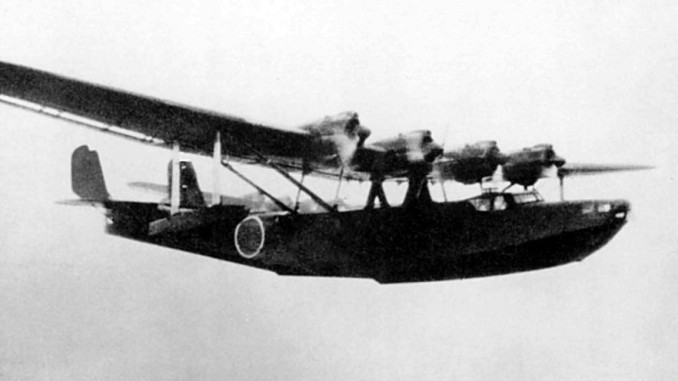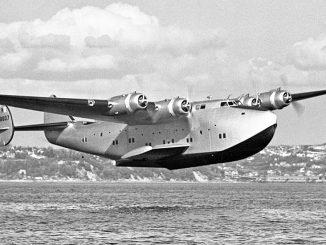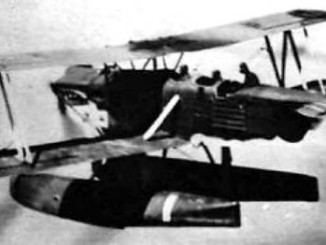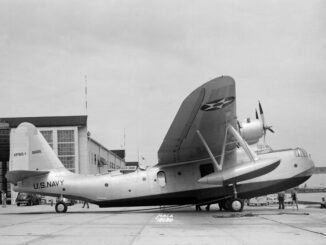
The Japanese Navy’s requirements for new aircraft in 1934 included a request for a new long-range, multi-engined reconnaissance flying boat capable of patrolling the huge distances of the Pacific Ocean. Kawanishi, building on their experience of building the H3K flying boat and working with the British Short Brothers, produced a design for a four-engine patrol bomber that was designated the Kawanishi H6K.
The H6K featured a huge parasol wing, similar in configuration to the PBY Catalina. Unlike the Catalina however the H6K had four motors and twin tails. Later versions carried almost 3,000 gallons of fuel and could stay out on patrol for up to 24 hours, highly advantageous when undertaking dangerous long-range reconnaissance missions. Up to 1,000kg of bombs could be carried, giving the H6K the ability to attack lightly defended targets. A pair of torpedoes could also be carried, although this a rarely used capability.
Gallery
Type 97s first appeared in 1938 during the China Incident, as the flying boats helped to maintain the blockade of the Chinese coast. By the time the Pacific War began H6Ks equipped four flying boat kokutai which supported the rapid advance of Japanese forces, including reconnoitring far flung Allied bases like Rabaul, Wake Island and Darwin.
H6Ks played a key role in locating American carrier task forces during 1942, particularly during the battles off Guadalcanal. Here the problems with the H6K’s design became clear, as American fighters found the big bombers particularly enticing targets which were prone to catching fire when attacked. The successor H8K took over front-line duties from the H6K during 1943, but the older aircraft nevertheless continued in service right up to the end of the war.
In 1942 the H6K was amongst the first Japanese aircraft to be assigned a codename by the Technical Air Intelligence team, receiving the reporting name “Mavis”.
Kawanishi H6K Type 97 Specifications
| Kawanishi H6K1 | |
| Role | Flying Boat |
| Crew | |
| Powerplant | 4x Mitsubishi Kinsei 43 (1,080hp) |
| Speed | |
| Ceiling | 0ft |
| Range | |
| Armament | |
| Ordnance | |
| Dimensions | 0ft 0in (length) 131ft 2in (wingspan) 20ft 6in (height) |
| Wing Area | 1830 sq.ft. |
| Weight | |
| Number produced | 3 |
| Kawanishi H6K2 | |
| Role | Flying Boat |
| Crew | 9 |
| Powerplant | 4x Mitsubishi Kinsei 43 (1,080hp) |
| Speed | 206mph (max) |
| Ceiling | 24,395ft |
| Range | 2,567 miles (internal) |
| Armament | 3x Type 92 7.7mm Machine Gun |
| Ordnance | 2,205lb bombs 2 torpedoes |
| Dimensions | 84ft 0in (length) 131ft 2in (wingspan) 20ft 6in (height) |
| Wing Area | 1830 sq.ft. |
| Weight | 22,796lb (empty) 35,274lb (gross) |
| Number produced | 10 |
| Kawanishi H6K2-L | |
| Role | Transport |
| Crew | 8 |
| Powerplant | 4x Mitsubishi Kinsei 43 (1,080hp) |
| Speed | 150mph (cruise) 207mph (max) |
| Ceiling | 24,395ft |
| Range | 2,690 miles (internal) |
| Armament | |
| Ordnance | |
| Dimensions | 81ft 8in (length) 131ft 2in (wingspan) 20ft 6in (height) |
| Wing Area | 1830 sq.ft. |
| Weight | 26,511lb (empty) 37,699lb (gross) 50,706lb (max) |
| Kawanishi H6K3 | |
| Role | Flying Boat |
| Crew | |
| Powerplant | 4x Mitsubishi Kinsei 43 (1,080hp) |
| Speed | |
| Ceiling | 0ft |
| Range | |
| Armament | |
| Ordnance | |
| Dimensions | 0ft 0in (length) 131ft 2in (wingspan) 20ft 6in (height) |
| Wing Area | 1830 sq.ft. |
| Weight | |
| Number produced | 2 |
| Kawanishi H6K4 | |
| Role | Flying Boat |
| Crew | 9 |
| Powerplant | 4x Mitsubishi Kinsei 46 (1,070hp) |
| Speed | 138mph (cruise) 211mph (max) |
| Ceiling | 31,520ft |
| Range | 4,112 miles (internal) |
| Armament | 4x Type 97 7.7mm Machine Gun 1x Type 99 20mm Cannon |
| Ordnance | 2,205lb bombs 2 torpedoes |
| Dimensions | 84ft 3in (length) 131ft 2in (wingspan) 20ft 6in (height) |
| Wing Area | 1830 sq.ft. |
| Weight | 25,755lb (empty) 37,400lb (gross) 47,300lb (max) |
| Number produced | 127 |
| Kawanishi H6K5 | |
| Role | Flying Boat |
| Crew | 9 |
| Powerplant | 4x Mitsubishi Kinsei 53 (1,300hp) |
| Speed | 161mph (cruise) 239mph (max) |
| Ceiling | 31,365ft |
| Range | 4,208 miles (internal) |
| Armament | 4x Type 97 7.7mm Machine Gun 1x Type 99 20mm Cannon |
| Ordnance | 2,205lb bombs 2 torpedoes |
| Dimensions | 84ft 1in (length) 131ft 2in (wingspan) 20ft 6in (height) |
| Wing Area | 1830 sq.ft. |
| Weight | 27,117lb (empty) 38,581lb (gross) 50,076lb (max) |
| Number produced | 36 |




this is my go to site. Pacific eagles clear explanations, esp of the FUNCTIONS of various models of aircraft. This resource goes some way towards addressing my profound ignorance of the technical dimension of
modern era military history. Thanks, Ann ☑
Is there any evidence documented that the Mavis operated at nite. Seems likely with its range to be taking-off in the nite to recon areas during the day lite hours, then return to base at nite. Appreciate the help…
Hi Rich, no such evidence that I know of. Sources on the actual operational usage of Japanese aircraft in English are very limited to my knowledge.
Everybody flew at night. The big boats, with lots of eyeballs aboard, long range and loiter times, were well adapted and equipped for night ops. The IJN had evolved night non-radar operations to a high degree, flying every sort of mission. Night operations also enhanced survival rates in the face of mounting Allied counter-air, though by 1944-45 Allied technical superiority in the form of advanced airborne radar(eg:AN/APS-4), sophisticated AAA and naval fire control systems, proximity fuzes, excellent C3I and radios in the hands of motivated and salty warriors backed by staggering industrial, material and logistic capacity negated any effort the Nips could mount.
The war goes 24/7 until the fat lady sings. Nobody concedes 12 hours of the day to their opponent without peril.